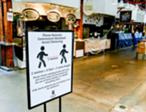The Vancouver Police Department is adding a sound cannon to its armoury on the eve of the Olympics, and the B.C. Civil Liberties Association doesn’t like the sound of it.
In a news release, the BCCLA summarized the situation and demanded a clear policy for police use of this new technology:
A representative for the Vancouver Police Department confirmed to the BCCLA last week that the VPD has acquired an LRAD (Long Range Acoustical Device) crowd control weapon for the 2010 Olympics. He advised that the VPD would be using the device to ensure that police instructions were clearly heard.
The sonic gun fires a concentrated beam of sound at its targets that can cause hearing damage and temporarily disrupt vision.
BCCLA President Robert Holmes pointed out that even as the Taser inquiry has not yet reported back, police are acquiring another high tech device that could be used to cause grievous pain.
“This crowd control weapon was obtained without any public discussion and without any defined policy for its safe and proper use being set in advance. Tasers were also brought in through such an ill-considered and backwards approach.”
American Technology Corporation describes the LRAD in great detail on its website. Among other attributes:
Security measures that enhance public safety initiatives are a critical priority in today’s increased threat environment. In any operational scenario, public safety tools must be portable, ruggedized, easy to operate, and cost effective. LRAD provides immediate enhancement to this fundamental communication and force protection requirement. ...
LRAD products use directionality and high acoustic output to clearly transmit critical information, instructions, and warnings well from 100 to 3000 meters.
LRAD systems can also transmit powerful deterrent tones to influence behavior in hostile situations. LRAD significantly extends the standoff and perimeter in friendly or escalated environments.
In a report on protests at the G20 meeting in Pittsburgh, Pennsylvania late in September, the New York Times described on how the LRAD was deployed:
The police fired a sound cannon that emitted shrill beeps, causing demonstrators to cover their ears and back up, then threw tear gas canisters that released clouds of white smoke and stun grenades that exploded with sharp flashes of light.
City officials said they believed it was the first time the sound cannon had been used publicly. “Other law enforcement agencies will be watching to see how it was used,” said Nate Harper, the Pittsburgh police bureau chief. “It served its purpose well.”
The entry on the LRAD in Wikipedia quotes a former American Technology official on the effect of the device:
Carl Gruenler, former vice president of military and government operations for American Technology Corporation (and who now runs a company making a competing device), says that being within 90 metres (98 yd) of the device is extremely painful, but its use should be limited to 270 metres (300 yd) to be effectively used. He concedes that the device is powerful enough to cause permanent auditory damage, but that it is only meant to be used for a few seconds at a time.
Countermeasures may include the use of passive hearing protection (earplugs, headsets), which may bring the sound down to ineffective levels. In addition, sound could be reflected from a solid surface, and redirected back to the originator.
Crawford Kilian is a contributing editor of The Tyee.










What have we missed? What do you think? We want to know. Comment below. Keep in mind:
Do:
Do not: